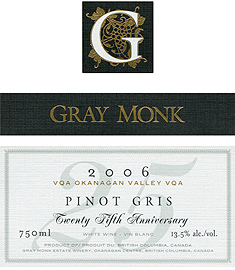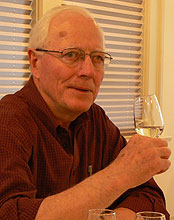

Gray Monk Cellars
2006 Pinot Gris(Okanagan Valley)
In British Columbia, Pinot Gris plantings, at 563 acres or 229 hectares in 2006, are second only to Chardonnay among the white varieties. Parallel to the rising popularity of Pinot Gris everywhere, it is just a matter of time before it becomes British Columbia’s number one white.
It was George and Trudy Heiss, the founders of family-run Gray Monk Estate Winery, who got the ball rolling when, in 1976, they imported from Alsace the first Pinot Gris vines to be planted in the Okanagan. Indeed, it is possible theirs were Canada’s first plantings of the variety.
There are at least 22 synonyms for Pinot Gris. A little used one in Germany and Austria (where the Heisses grew up) is Grauer Mönsch. That translates as gray monk. The Heisses used that name for the winery they launched in 1982. Pinot Gris remains the winery’s signature varietal, accounting for about 9,000 cases a year, about 13% of the winery’s annual production.
Because Pinot Gris skins often are pink at maturity, this wine has a slight and attractive blush. The aromas suggest pears and bananas. On the palate, there are layers of fruit flavours, including pear, honeydew melon, citrus and cantaloupe. The finish is crisp and dry. 87 points.
Reviewed July 17, 2007 by John Schreiner.
Other reviewed wines from Gray Monk Cellars
The Wine
Winery: Gray Monk Cellars |
The Reviewer John Schreiner
John Schreiner
John Schreiner has been covering the wines of British Columbia for the past 30 years and has written 10 books on the wines of Canada and BC. He has judged at major competitions and is currently a panel member for the Lieutenant Governor’s Awards of Excellence in Wine. Both as a judge and as a wine critic, he approaches each wine not to find fault, but to find excellence. That he now finds the latter more often than the former testifies to the dramatic improvement shown by BC winemaking in the past decade. |












